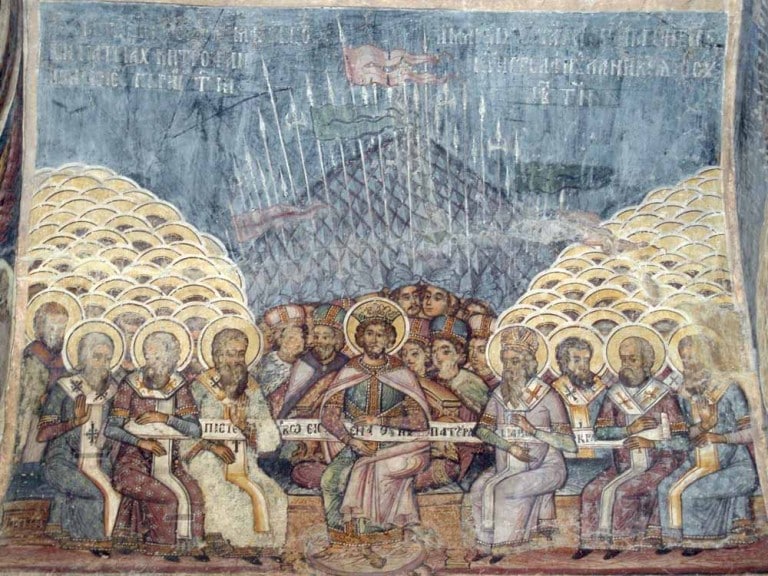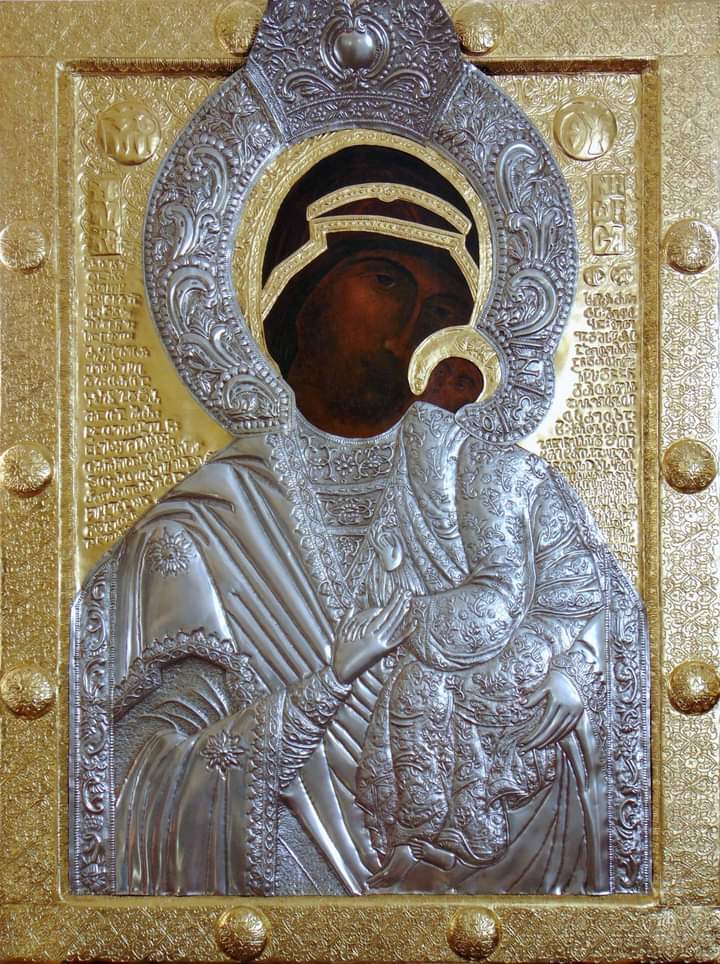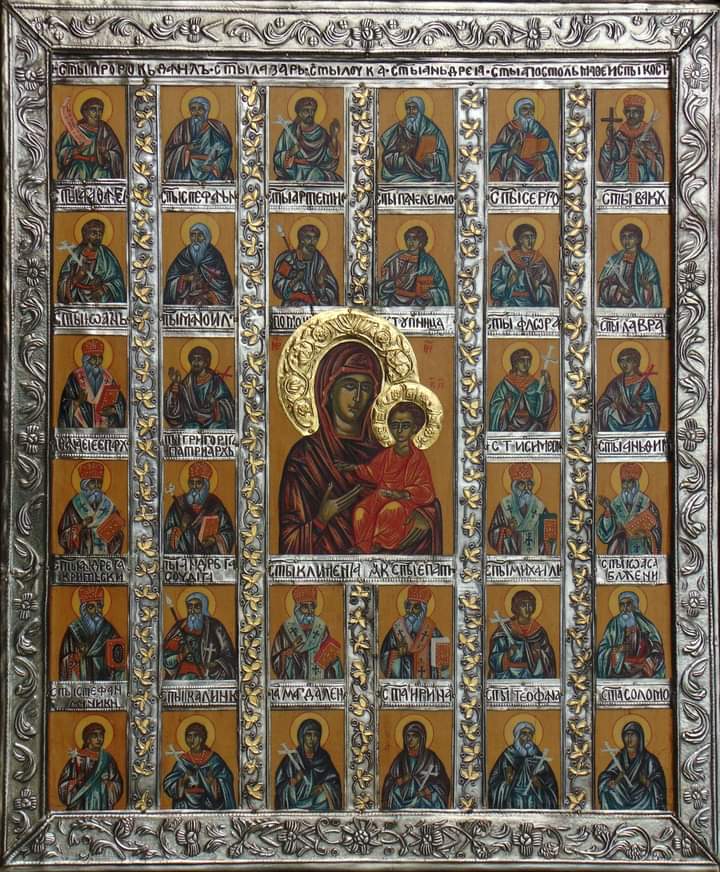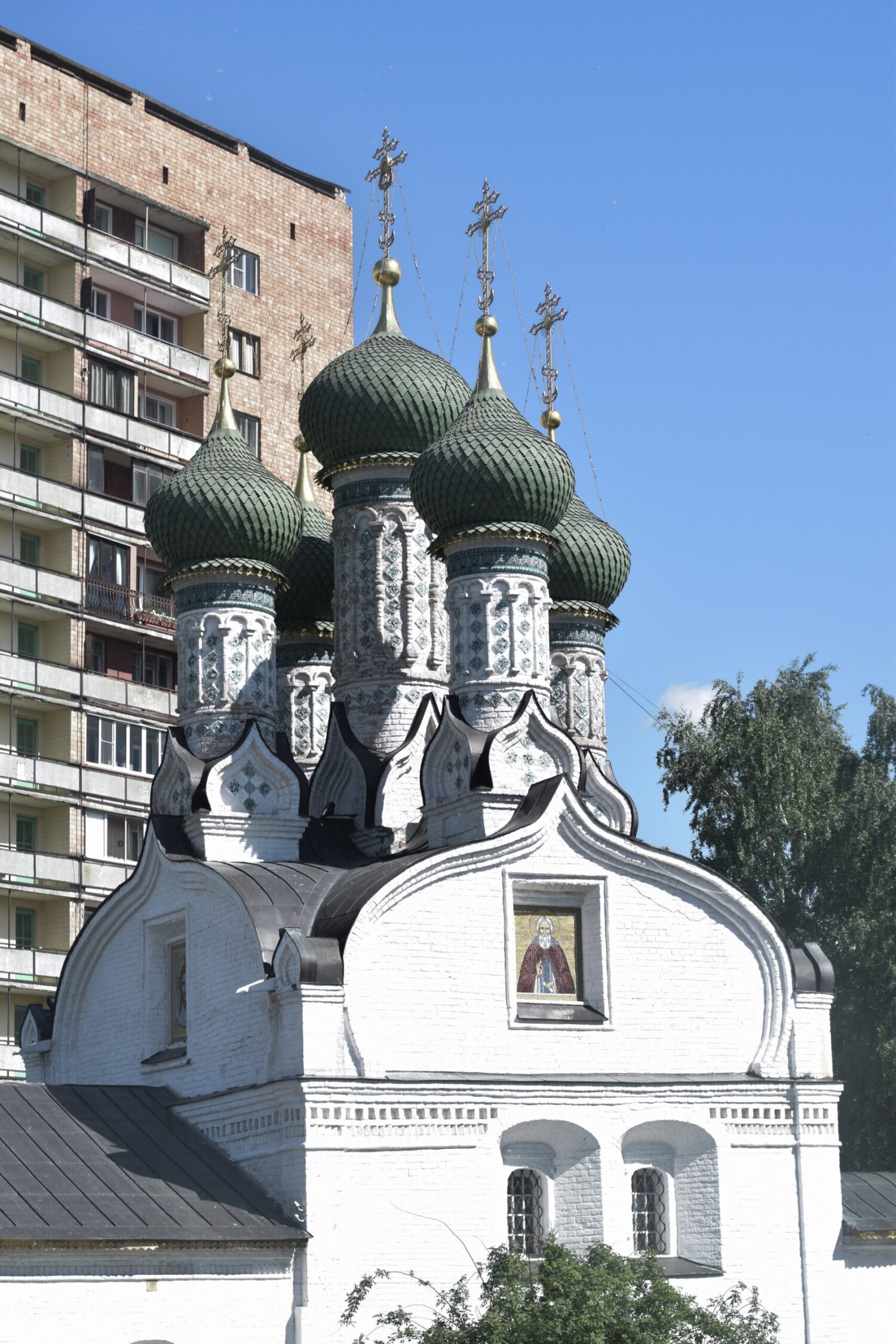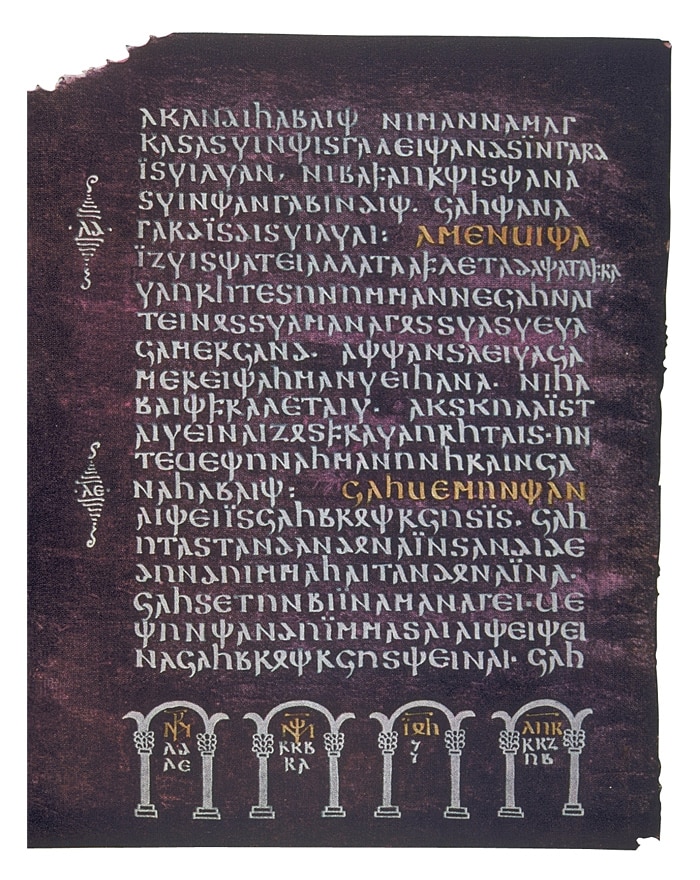Author: protopresbiter Alexander Schmemann
In the Arian controversy, as in a knot, many threads are gathered, many questions are joined. This is the beginning of the great theological controversies in which almost five centuries of the history of the Church will pass and which will leave us as a heritage the inspired writings of the fathers and teachers of the Church, together with the precise formulations of the ecumenical councils. However, this struggle for the Truth is soon complicated by the involvement of state power. It ceases to be purely ecclesiastical and acquires a new state dimension. Thus, in its course, the faith of the Church was not only refined, but also the slow and painful birth of a Christian Byzantium took place. Outwardly, the fourth century is probably one of the most tragic in the history of the Church – it was then that the theme of the Christian world was put into its real depth for the first time, that idea and that vision were born that will never be completely erased from the church consciousness.
The dispute began in Alexandria, the capital of Christian thought. Arius, a learned Alexandrian presbyter and preacher, began to teach that Christ, though the son of God, must necessarily be recognized as created in time—one of God’s creations, since birth cannot but be an occurrence in time. He was born of God for the creation of the world, an instrument of creation, and therefore there was a time when He was not. Therefore, the Son of God is completely different from the Father and unlike Him.
It is difficult for the modern ecclesiastical society, for which theological interests are generally alien (they are only unnecessary and dangerous assumptions), to understand, in the first place, how such a teaching could have arisen, which obviously goes against the most basic positions of Christianity, and, secondly, the resonance of this controversy for five whole decades, during which it did not cease to tear the Church apart. In order to understand this, it is necessary to feel, in the words of Archpriest Georgi Florovski, the fact that for the Christians of those times, theology was really a vital matter, a spiritual feat, a confession of faith and a creative solution to life’s problems, that apparently arguing about words and formulas, they actually defended and defended precisely the vital – today they would call it the practical or existential meaning of Christianity, which is contained in the word salvation. Because salvation is not a magical, externally performed action – it is a gift from God, the achievement of which depends on the complete perception and assimilation by man. In this situation, however, theology, i.e. the insight, expression and confession of the Truth through the means of the word, is revealed as a higher, royal vocation of man; in it, man’s participation in the meaning of divine things is restored, man’s birthright in the world as a rational person. Theology is the revelation, in the concepts of reason, of the faith of the Church – not the verification of this faith by the means of reason and not subordination to reason, but quite the opposite – the extension of reason itself to the Revelation, its agreement with the true and evident faith. Faith precedes theology, and therefore theological development can be spoken of as a gradual perception and refinement of the originally complete faith. From the example of Origen, we see that the first attempts in this direction were imperfect and even turned out to be heretical. However, this only shows how difficult it was to find the right words to express the faith; centuries were to pass until the thought itself was assimilated into the spirit of Christianity.
By faith in the Father, Son and Holy Spirit, i.e. with the experience of the Triune God, the Church has lived since its first days. The meaning of the Gospel is in the Revelation of the Trinity as perfect unity, perfect love and perfect life. The grace of the Lord Jesus Christ and the love of God and the Father, and the communion of the Holy Spirit – we can find this liturgical blessing everywhere in the messages of St. Ap. Pavel. However, if in the Revelation about the Triune God are the source of our salvation and the power of the Christian life, then this Revelation must also enlighten the human mind, expand it to comprehend the mystery that was revealed to us by Christ.
Because accepting the Truth always means effort, crisis and aging. Natural reason confronts Revelation as a contradiction and a paradox. How can the original belief of the Church in the Triune God be reconciled with such an undoubted affirmation of His unity – with that monotheism, in whose name Christians, following the Jews, reject every form of paganism? This faith must be revealed; the experience must be explained. Thus, the first fundamental theological question arises in the church’s consciousness – the question of the Trinity.
* * *
Arius is wrong when he approaches the resolution of the theological question about St. Trinity exclusively as a philosopher who looks at everything from the point of view of logic. There are two cornerstones and vital in the proper sense of the word truths of Christianity: about the One God and about the salvation of the world accomplished by the Son of God. However, Arius perceives these truths as abstract situations. He is a convinced monotheist, but not in the spirit of the Old Testament, but in the spirit of the philosophical monotheism prevailing in the Hellenistic world at that time, namely – recognition of some One or One, which lies at the basis of everything that exists as its beginning and as unifying principle of everything plural. God is One, and in Him there can be no multiplicity; but since He has His Son, that Son is already different from Him and therefore cannot be God. The Son is born, but the birth is the coming into being of something that did not yet exist. The Son is born for the sake of creation, for the salvation of creation, but He is not God in that single and absolute sense in which God is the Father. Arianism thus manifests itself as an attempt to rationalize Christianity. In this experience, it is not the living religious experience that fertilizes thought and makes it see and understand things that it previously did not understand, but on the contrary, the experience of faith dries up in the course of logical analysis and is turned into an abstract construction. Arianism, however, is in tune with the age. It offers both a strict monotheism and a rejection of everything irrational and incomprehensible. It is accessible to the average mind who seeks a reasonable faith rather than the actual Tradition of the Church with its biblical, realistic images and expressions. As one historian has rightly remarked, Arianism deprived Christianity of its living religious content, turned it into theism—into cosmology and morality.
The first reaction against Arianism is the reaction of the living faith, which feels shaken by this perversion of the very sanctuary of the Church. Arius was condemned by his own bishop, Alexander of Alexandria. However, this is only a condemnation, not an answer. In his answer, Bishop Alexander himself gets confused and fails to find the right words. For his part, Arius turned for support to his former friends from the school of the famous Antiochian theologian Lucian. As educated theologians, many of them occupy episcopal chairs. Special attention should be paid here to the two Eusebians – Eusebius of Caesarea, the first church historian (whose Church History is one of our most important sources for the life of the early Church), and Eusebius of Nicomedia, later baptized imp. Constantine the Great. It must be said that they support Arius not only for personal reasons. During these years, the intelligentsia grew in the Church, which thirsted for a reasonable explanation of the faith and for which the Church’s teaching suffered from a lack of philosophical character. In this sense, Arianism seems perfectly adequate as a modern interpretation of church teaching, acceptable to the broad circles of educated people. Thus, the local Alexandrian dispute spread gradually throughout the East.
At this point, the imp intervenes in the dispute. Constantine the Great. We must try to imagine what the conversion of the emperor himself meant for the Church – after three centuries of persecution – in order to understand why the court of St. Constantine became a center of attraction, not only for the opportunists and careerists, but and for those who, inspired by the victory of Christ, dream of spreading this victory throughout the world. In a short time, the emperor and the Empire turn into providential instruments of the Kingdom of Christ. A circle of Christian advisers was immediately formed around St. Constantine the Great – something like his unofficial headquarters, in which very early, in fact, from the very beginning of Constantine’s appearance in the East, the Nicomedian bishop Eusebius occupied a prominent place – the first of the unfortunate series of court bishops53. Of course, Constantine himself was not able to navigate the essence of the theological dispute, but he was shocked by the emergence of a new dispute in the Church precisely in the years of his full celebration. The victory over Licinius in 324 definitively confirmed his one-man power and before him the image of an Empire, united not only politically, but also internally spiritually renewed by a single Church. However, instead of realizing these dreams of his, he is faced with the sad reality of new disputes and divisions. It is very likely that the idea of a council of all the bishops, as a means of settling the dispute, was suggested to him by his Christian advisers. St. However, Constantine wished to make this council a symbol and crowning of his victory, as well as of the new position of the Church in the Roman Empire. Thus, in the spring of 325, the First Ecumenical Council was convened in Nicaea – ecumenical not because of the number of bishops present (the Tradition of the Church sets this number at 318), but from the point of view of its design and purpose (1). And indeed, for the first time after the long centuries of semi-legal existence, bishops from all corners of the Church gathered in Nicaea, many of whom still bear the scars of wounds and bodily injuries received during the Diocletian persecution. What a tangible experience of celebration and victory! To this is added the splendor of the reception, the unprecedented solemnity of the welcome, the generosity and kindness of the emperor – factors that cannot but strengthen the joyful confidence at the beginning of a new era, the faith in the actual victory of Christ over the world. This is how Constantine himself perceived the council above all. He scheduled its opening on the day of the twentieth anniversary of his rule. He wants this day to pass in parade and joy, not in the disputes he hates. In his speech to the bishops on the opening day of the council, he says that disputes between them are more dangerous than wars and other conflicts, and give him the most grief of all.
Of course, the importance of the Council of Nicaea is above all in the great victory of the Truth withheld from it. No protocols or acts have been preserved from this council, as from other ecumenical councils. It is only known that the council condemned Arianism and in the traditional content of the Baptismal Creed (2) introduced a new specification of the relationship of the Son to the Father, calling the Son one with the Father, i.e. having that essence which the Father has, and therefore equal to Him in Godhead. The term used, according to Vasily Bolotov, is so precise that it excludes any possibility of reinterpretation (3). With it, Arianism was condemned unconditionally. This very term, however, remained for many years a stone of stumbling and temptation, leading the Church into prolonged turmoil.
This turmoil filled the next fifty-six years – until the convening of the Second Ecumenical Council in Constantinople in 381. In the course of its development, of course, individual themes must be distinguished, but their mutual connection must always be sought. Almost equally, these themes determine the course of the subsequent history of the Church – a history in which there is hardly another half-century that has been so decisive.
Externally, the reason for the continuation of this turmoil is that, although condemned, the Arians not only did not surrender, but with the help of the most complicated intrigues they managed to attract the state power to their side. With this, the first major topic is set – the participation of the emperor in the life of the Church. From now on we will say that from this point of view the balance sheet of the fourth century is more than negative; it is even tragic. Here, however, it is necessary to immediately determine the second topic of the Arian dispute – the celebration of the Arians would have been impossible even with the help of the emperor, in the event that the Church, which had condemned Arius with complete unanimity, had proved to be united in this condemnation and especially in the acceptance of the doctrine proclaimed at Nicaea. However, this is not what happens. The Council of Nicaea brings confusion and doubt into minds, which begs the question of the theological content of the post-Nicene controversy. And precisely in this is the positive meaning of the fourth century, which clearly shows the categorical power of the Truth in church life even in hopeless circumstances.
Most of the participants of the council took lightly the condemnation of Arianism, in which they saw a too obvious distortion of the primitive Tradition of the Church. However, the matter is quite different with the disclosure of the positive doctrine of the Trinity, which is contained in the term oneness. This word was proposed and practically imposed on St. Constantine, and through him on the council itself, by a small group of far-sighted and courageous theologians who understood the inadequacy of the condemnation of Arius and the need to cut the Tradition of the Church into clear concepts. To the majority of the bishops of the council, however, the word is foreign and unintelligible; with it, for the first time, a philosophical term, which is foreign to the Holy Scriptures, was introduced into the teaching of faith. At the same time, this term is suspect, since the oneness can return the Church to the recently overcome temptation of Sabelianism, which merges the Father and the Son into one entity. Nevertheless, the council – at the express request of the emperor – accepted this term in the Creed, without, however, delving much into its meaning. The bishops think that what is important is the condemnation of heresy, and as for the Creed – practically every local church has its own symbol, which agrees with all the others in substance, though not quite literally.
In this way, outwardly, the council ended successfully, if we do not consider the repeated, after Donatism, mistake of Constantine, who sent Arius and his like-minded people into exile and thus once again mixed the judgment of the Church with the judgment of Caesar.
This is precisely where the group of court bishops we mentioned above manifests itself. This group was composed exclusively of friends of Arius, and at their head was Eusebius of Nicomedia. These are men forced to accept the condemnation of their friend, but only in view of the unanimity of the majority of the bishops of Nicaea, while in fact they do so only with a contrite heart and a thought of revenge. To declare openly against the Council is impossible for them, and therefore they resort to the means of intrigue. Taking advantage of the bishops’ indifference to the positive revelation of the Nicene Creed, they decided simply not to mention it, but to direct all their energies to that handful of theologians who alone grasped the full meaning of the term oneness. Denunciations and accusations are underway that have nothing to do with theology. Their first victim was Eustathius of Antioch, whom they succeeded in defaming in the eyes of the emperor and causing him to be sent into exile. After their success, for many years, the young – newly elected – Alexandrian bishop St. Athanasius the Great (328–373), who in all probability was the main inspirer of the Nicaean unity, became the main object of their intrigues. And again in the same way, without entering into any theological dispute with him, the enemies of the Council of Nicaea succeeded in obtaining his condemnation on the charge of some canonical offences—first at the episcopal council of Tire in 331, and then by the exile of St. Athanasius by order of the emperor to Trier on the Rhine. St. Constantine the Great could not tolerate troublemakers, and it was precisely as such that they managed to present the Bishop of Alexandria before him. Having achieved the removal of St. Athanasius, it was not difficult for the court bishops to restore to Alexandria Arius himself, who signed some vague penance in this connection, after which he was received into communion. St. Constantine, who probably never managed to understand the essence of the dispute, thinks that everything is already in order – peace has been achieved in the Church again, and only enemies of this peace can recall things that have remained in the past. The opportunists are celebrating on all fronts in the apparent misunderstanding and silence of the entire Church.
But Constantine’s days were drawing to a close. In the same year 336, when St. Athanasius was exiled, he celebrated his last – thirtieth – anniversary from the beginning of his reign. However, the empire is now ruled by another Constantine. Over the years, the mystical mood that has lived in him since his childhood grows. At the end of his days, even the interests of the state took a backseat to this mood. The speeches and celebrations of this ante-mortal jubilee were illumined by that light which grew more and more strongly in his soul, and shortly before his death hands were laid on him, he became famous and no longer wore his royal robes. His longtime dream was to be baptized in the waters of the Jordan, but this did not come true. Constantine was baptized by Eusebius of Nicomedia, and from that moment on he lived with the joyous assurance of the nearness of Christ and His eternal light. St. Constantine the Great died on the sunny noon of Pentecost. Whatever his faults, and perhaps even his crimes in his personal life (such as the murder of his son Crisp – a dark family drama that remains unsolved until the end), we can hardly doubt that he is a man who invariably he aspired to God, lived with the thirst for the absolute and wanted to establish on earth the radiance of heavenly justice and beauty. The greatest earthly hopes of the Church, her dreams for the celebration of Christ in the world, are connected with his name. This is also the reason why the love of the Church and her gratitude to him prove to be stronger than the merciless but fickle and often superficial judgment of historians.
Notes:
1. Until the rise of Constantinople (formerly Byzantium) as the new capital of the Empire and a significant ecclesiastical center, Nicomedia (today the city of Izmit, about 100 km east of Istanbul in Turkey) played a leading role in the region, including as an ecclesiastical center in whose diocese Byzantium itself is also located. In Nicomedia at the end of the 3rd and the beginning of the 4th century is the palace of the imp. Diocletian (284–305), after in 286 he introduced the well-known tetrarchy system into the administration of the Roman Empire. Nicomedia also played the role of the interim capital of Constantine the Great himself until the official proclamation of Constantinople.
2. At the time of the First Ecumenical Council, Nicaea (today the city of Iznik, southeast of Istanbul, on the shores of Lake Nicaea) was also a leading center in the region, with which Nicomedia competed as the capital of the province of Bithynia. In Nicaea Emp. Constantine I had a palace in which the said council was opened (May 20, 325). In the thirteenth century, during the Latin rule in Constantinople (1204–1261), Nicaea was the strongest center of Byzantine power. (Bel. trans.)
3. Here we are talking about the Baptismal symbol of the Church of Caesarea, which was proposed to the council by Eusebius of Caesarea, and not about any Baptismal symbol of the Church in general. The beginning of the 4th century was a time when the churches in some places still used different, although they agreed with each other in the most important, baptismal symbols. See below. (Bel. trans.)
4. See: Bolotov, V. Cit. cf., item IV. M., 1994 (phototyped), p. 41.
Source: From the Bulgarian edition of the book “The Historical Path of Orthodoxy”, Protopr. Alexander Schmemann, IC “Omofor”, Sofia, 2009.
Photo: Fresco of the First Council of Nicaea (325).



